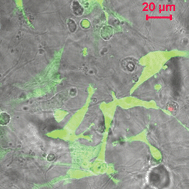Injectable scaffolds for tissue regeneration
Abstract
Tissue engineering aims to develop functional substitutes for damaged or diseased tissues through complex constructs of living cells, bioactive molecules and three-dimensional porous scaffolds, which support cell attachment, proliferation and differentiation. Such constructs can be formed either by seeding cells within a pre-formed scaffold or through injection of a solidifiable precursor and cell mixture to the defective tissue. As cell and bioactive molecule carriers, injectable scaffolds are appealing, particularly from the clinical point of view, because they offer the possibility of homogeneously distributing cells and molecular signals throughout the scaffold and can be injected directly into cavities, even of irregular shape and size, in a minimally invasive manner. In this paper the challenges in designing an injectable scaffold from the viewpoint of materials chemistry and the solidification mechanisms of injectable precursors are discussed. The applications of injectable scaffolds in angiogenesis, bone repair and cartilage regeneration are described.


 Please wait while we load your content...
Please wait while we load your content...